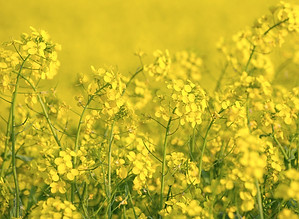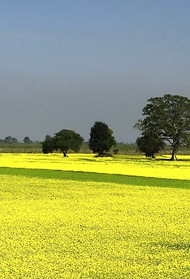
Catch Crops and Green Manure
A catch crop is a fast-growing crop cultivated between main crops, serving as green manure or livestock feed.
These crops offer numerous benefits, such as enhancing soil structure and fertility, preventing erosion with their deep root systems, and providing vital cover for farmland and game birds.
Additionally, catch crops suppress weeds, support biodiversity, and promote sustainable agricultural practices.
Catch Crops


Green Manure crops are fast-growing plants with deep roots, sown in fields after harvest to rejuvenate the soil. Hardy and adaptable, these crops thrive through winter with minimal sunlight, making them ideal for covering bare soil during the off-season. Green manures can grow for a few months or be left in place for 1-2 years.
These crops offer numerous benefits: their deep roots draw up buried nutrients, nitrogen-fixing nodules enrich the soil, and certain varieties break up heavy clay. Their dense foliage smothers weeds, while the root systems prevent soil erosion and nutrient loss during winter rains. When it’s time to plant again, the green manure crops can be cut down and either dug into the soil or left to decompose, releasing valuable nutrients back into the earth.
Using green manures is an organic, sustainable way to replenish soil nutrients, suppress weeds, and provide habitats for beneficial insects. This method eliminates the need for chemical fertilizers while improving soil health, boosting biodiversity, and supporting higher, organic yields in subsequent crops.

Green Manure
Standard Green Manure Mixtures
Our Rye and Vetch Mix is an excellent choice for soil improvement and high-quality forage production. This combination is ideal for grazing, silage, or as a green manure to boost soil health and fertility.
Rye and Vetch Mix
70% Forage Rye
30% Vetch
Mixture Details >

Sowing rate: 75kg per acre
Our Westerwolds and Vetch Mix is perfect for rapid forage production and soil enrichment. This mix is ideal for short-term grazing, silage, or as a green manure, delivering both quality forage and improved soil fertility.
Westerwolds and Vetch Mix
30% Westerwolds
70% Vetch
Mixture Details >

Sowing rate: 25kg per acre
Our Black Oats and Vetch Mix is a versatile choice for sustainable farming practices. Ideal for grazing, green manure, or cover cropping, this mix enhances soil fertility and supports livestock nutrition.
Black Oats and Vetch Mix
70% Black Oats
30% Vetch
Mixture Details >

Sowing rate: 12kg per acre
This mix is designed to improve soil health and provide excellent forage options. Together, they promote soil structure, boost fertility, and provide a dual-purpose solution for grazing and soil management.
Fodder Radish and Tillage Radish Mix
40% Fodder Radish
30% Fodder Radish
30% Tillage Radish
Mixture Details >

Sowing rate: 5kg per acre
Our Black Oats, Radish and Mustard Mix is a powerful combination for soil improvement and cover cropping. This mix enhances soil health, boosts fertility, and is ideal for green manure or livestock grazing.
Black Oats, Radish and Mustard Mix
80% Black Oats
15% Fodder Radish
5% Mustard
Mixture Details >

Sowing rate: 10kg per acre
This mix is an excellent choice for soil health and forage needs. Together, they create a versatile mix ideal for green manure, weed control, and enhancing soil fertility, with the added option of grazing benefits.
Nematode Resistant Radish and Mustard Mix
50% Fodder Radish
50% Mustard
Mixture Details >

Sowing rate: 10kg per acre

Our Forage Rye and Mustard Mix offers a fast-growing solution for soil cover, weed suppression and forage production. Forage rye provides excellent biomass and soil structure improvement, while mustard adds quick ground cover and natural pest control. This versatile mix is ideal for green manure, grazing, or protecting fallow land, enhancing both soil fertility and farm productivity.
80% Forage Rye
20% Mustard
Mixture Details >
Forage Rye and Mustard Mix
Sowing rate: 20kg per acre
Green Manure Clovers

Balansa Clover
Trifolium michelianum
Sowing rate: 4kg per acre

This winter-hardy annual thrives in a range of soil types and is valued for its versatility. Its deep taproots improve water infiltration and drainage, making it an excellent choice for enhancing soil structure and managing moisture levels in various conditions.

Berseem Clover
Trifolium alexandrinum
Sowing rate: 6kg per acre

This clover is highly versatile and fits seamlessly into nearly all crop rotations. As a non-host plant for beet cyst nematodes, it helps protect subsequent crops while contributing to soil health through nitrogen fixation and improved fertility.

Crimson Clover
Trifolium incarnatum
Sowing rate: 6kg per acre

This fast-growing, bulky annual clover is ideal for short breaks in crop rotations, offering a quick and efficient way to boost soil fertility. Its rapid growth and nitrogen-fixing capabilities make it an excellent choice for improving soil health and preparing fields for the next planting.

Persian Clover
Trifolium resupinatum
Sowing rate: 4kg per acre

This annual clover thrives in most soil types and is perfect for situations requiring a short-term nitrogen boost. Its quick growth and nitrogen-fixing properties make it an excellent choice for improving soil fertility in a limited timeframe.
Radishes

Fodder Radish
Raphanus sativa
Sowing rate: 5kg per acre

Fodder Radish is a fast-establishing, non-tuberous crop with excellent soil coverage. It improves soil structure and fertility while helping to reduce cyst nematodes in crops like sugar beet and potatoes, making it a valuable tool in crop rotations.

Tillage Radish
Raphanus sativus
Sowing rate: 3kg per acre

This crop germinates and grows quickly, producing deep, thick radishes that effectively break up soil compaction. It also holds and releases vital nutrients while suppressing nematodes, improving soil health and fertility.
Mustards

White Mustard
Sinapsis alba
Sowing rate: 6kg per acre

Mustard is a cruciferous plant commonly used as a break crop to enhance soil structure and fertility. It establishes quickly, is drought-tolerant, and, when used in rotations with beets, a nematode-resistant variety is ideal for reducing pest pressure.

Brown Mustard
Brassica juncea
Sowing rate: 2kg per acre

Quick to establish, brown mustard provides effective weed suppression and improves soil structure. It acts as a strong nitrogen catcher when ploughed back into the soil and helps reduce potato cyst nematodes, making it a valuable addition to crop rotations.
Miscellaneous

Phacelia
Phacelia tancetifolia
Sowing rate: 4kg per acre

Phacelia is particularly beneficial for sugar beet farms as it is nematode-neutral, helping to break the nematode breeding cycle. Not winter-hardy, it is best sown in spring or summer, where it breaks down over the winter, leaving fertile ground for spring crops.

Black Oats
Avena strigosa
Sowing rate: 20-30kg per acre

This crop has a high capacity to reduce free-living nematodes (Pratylenchus spp.), making it effective in controlling soil pests. It establishes quickly and competes well against weeds, promoting healthy soil and better crop growth.



Biofumigation
Biofumigation is the incorporation of fresh plant material into the soil, which then releases several beneficial substances to suppress soil-borne pests and pathogens. These substances include glucosinates – a chemical agent that makes certain members of the Brassica family hot and spicy – which are at their highest concentration when the plant is flowering. When the plants are finely chopped (chaffed) and worked into the soil, the glucosinates are converted enzymatically into MITC (methyl isothyocianates) which are the actual active ingredients and are highly toxic to pests and pathogens.
Plants from the Cruciferae family (Brassicaceae) release large amounts of these toxic compounds in the soil and are considered the best species to use for biofumigation, as they target pests such as fungal mycelia, mobile nematodes and germinated weeds. Biofumigation is an effective method of disinfecting soil and increases the uptake of nutrients by plants, as with soil solarization. It is also a similar process to green manuring, as biofumigation incorporates nitrogen back into the soil, increasing the yield of the cash crops that follow. Biofumigation is an effective, all-natural alternative to chemical insecticides and herbicides, helping to keep toxic chemical run-off out of the water supply and protecting the health of growers and consumers.




